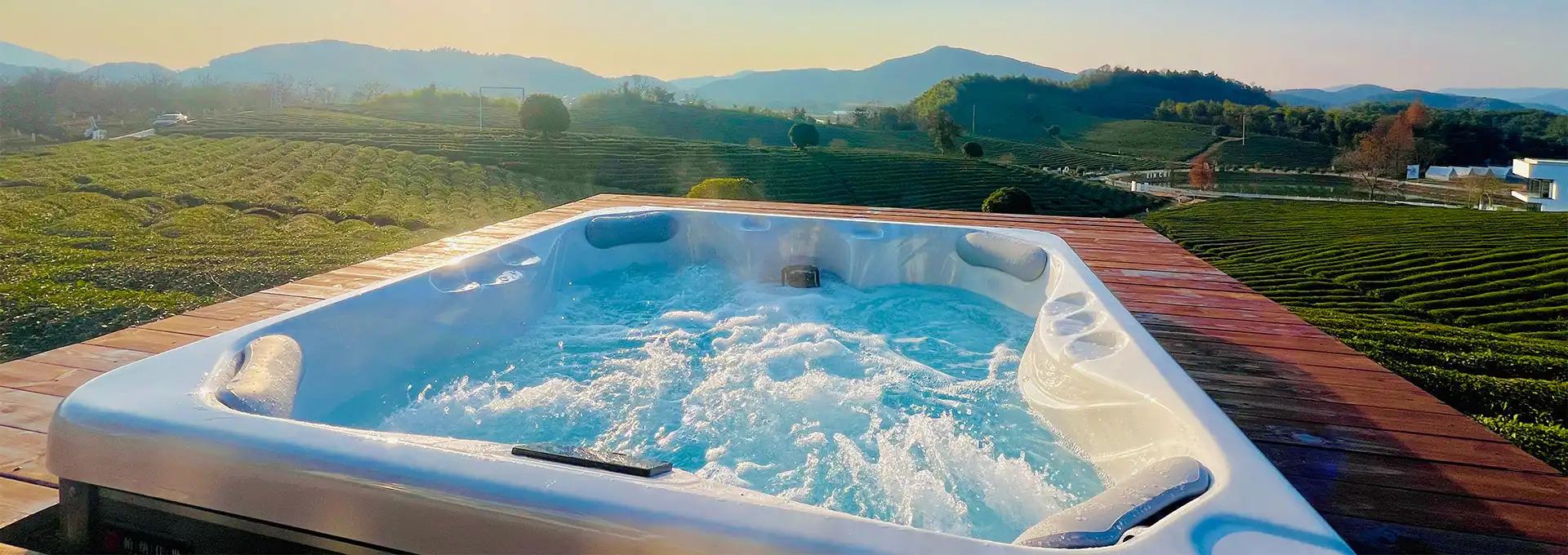How to control ph in a spa?
2025-06-03 17:28:37
Maintaining the proper pH level in your spa is crucial for ensuring a safe and enjoyable experience. pH, which measures the acidity or alkalinity of water, plays a significant role in the overall water chemistry of your spa. This article will guide you through the process of controlling pH in your spa, with a focus on the popular 7 M swim spa. We'll explore various aspects of pH management, common issues, and effective solutions to keep your spa water balanced and crystal clear.
What factors affect pH levels in a 7 M swim spa?
Water Source and Initial pH
The pH level of your 7 M swim spa can be influenced by various factors, starting with the source of water you use to fill it. Different water sources, such as municipal water, well water, or even rainwater, can have varying pH levels. When filling your 7 M swim spa, it's essential to test the initial pH of the water and make necessary adjustments. Municipal water typically has a pH range of 6.5 to 8.5, while well water can vary widely depending on the mineral content. Understanding your water source's characteristics will help you better manage pH levels in your 7 M swim spa from the start.
Bather Load and Organic Contaminants
The number of people using your 7 M swim spa, known as the bather load, can significantly impact pH levels. As swimmers enter the spa, they introduce organic contaminants such as sweat, oils, and cosmetics. These contaminants can alter the water chemistry and affect pH levels. In a 7 M swim spa, which is designed for exercise and relaxation, the bather load can be higher than in traditional hot tubs. This increased usage means more frequent pH testing and adjustments may be necessary to maintain optimal water quality. Regular shock treatments can help oxidize these contaminants and stabilize pH levels in your 7 M swim spa.
Chemical Treatments and Sanitizers
The chemicals and sanitizers used to maintain your 7 M swim spa can also impact pH levels. Chlorine and bromine, common sanitizers used in spas, can affect pH differently. Chlorine tends to lower pH over time, while bromine has a more neutral effect. Additionally, other chemical treatments such as alkalinity increasers, pH increasers, or decreasers can directly influence the pH of your spa water. When using these products in your 7 M swim spa, it's crucial to follow the manufacturer's instructions and test the water regularly to ensure proper balance. Balancing chemicals should be added gradually, allowing time for them to dissolve and circulate throughout the 7 M swim spa before retesting and making further adjustments.
How often should I test and adjust pH in my 7 M swim spa?
Regular Testing Schedule
Maintaining proper pH levels in your 7 M swim spa requires a consistent testing schedule. For optimal water quality and equipment longevity, it's recommended to test the pH of your 7 M swim spa at least 2-3 times per week. However, if your spa experiences heavy use or you notice any changes in water clarity or odor, more frequent testing may be necessary. When testing the pH of your 7 M swim spa, use a reliable test kit or test strips designed specifically for spa water. These tools will provide accurate readings, allowing you to make informed decisions about pH adjustments. Remember that the ideal pH range for a 7 M swim spa is between 7.2 and 7.8, with 7.4 to 7.6 being the sweet spot for both comfort and effectiveness of sanitizers.
Factors Influencing Testing Frequency
Several factors can influence how often you need to test and adjust the pH in your 7 M swim spa. The frequency of use is a primary consideration – a heavily used spa will require more frequent testing and adjustments than one that sees occasional use. Environmental factors, such as rainfall, high temperatures, or exposure to direct sunlight, can also affect pH levels in your 7 M swim spa. Additionally, if you've recently added new chemicals or performed a shock treatment, it's important to test the pH more frequently in the following days to ensure proper balance. For 7 M swim spas used for exercise, the increased movement and agitation of the water can lead to faster pH fluctuations, necessitating more vigilant monitoring.
Adjusting pH Levels
When adjusting the pH levels in your 7 M swim spa, it's crucial to make gradual changes. If your test results show that the pH is too high (above 7.8), you'll need to add a pH decreaser. Conversely, if the pH is too low (below 7.2), a pH increaser will be necessary. When adding these chemicals to your 7 M swim spa, always follow the manufacturer's instructions for dosage based on your spa's water volume. After adding the pH adjuster, run the spa's jets for at least 15-30 minutes to ensure proper circulation and distribution of the chemicals. Wait at least 6 hours before retesting the water to allow the chemicals to take full effect. If further adjustments are needed, repeat the process until the pH falls within the ideal range for your 7 M swim spa.
What are the consequences of improper pH levels in a 7 M swim spa?
Effects on Swimmer Comfort
Maintaining proper pH levels in your 7 M swim spa is crucial for swimmer comfort. When pH levels are too high or too low, it can lead to various discomforts for those using the spa. In a 7 M swim spa with high pH levels (above 7.8), swimmers may experience skin and eye irritation, as well as a strong, unpleasant chlorine odor. The water may feel slippery or slimy to the touch, making the swimming experience less enjoyable. On the other hand, low pH levels (below 7.2) in a 7 M swim spa can cause stinging eyes, dry and itchy skin, and even damage to swimwear. These discomforts can significantly impact the overall experience of using your 7 M swim spa, potentially discouraging regular use and exercise sessions.
Impact on Sanitizer Efficiency
The pH level in your 7 M swim spa plays a crucial role in the effectiveness of sanitizers like chlorine and bromine. When pH levels are outside the ideal range, it can significantly reduce the efficiency of these important chemicals. In a 7 M swim spa with high pH levels, chlorine becomes less effective at killing bacteria and other contaminants. This can lead to cloudy water, algae growth, and an increased risk of waterborne illnesses. Conversely, low pH levels in a 7 M swim spa can cause sanitizers to dissipate too quickly, requiring more frequent additions and potentially leading to chemical imbalances. Maintaining proper pH levels ensures that your sanitizers work optimally, keeping your 7 M swim spa clean, clear, and safe for all users.
Damage to Spa Equipment
Improper pH levels can have severe consequences for the equipment in your 7 M swim spa. When pH levels are too low (acidic), it can cause corrosion of metal components, including heaters, pump impellers, and other vital parts of your spa's circulation system. This corrosion can lead to premature equipment failure and costly repairs. In a 7 M swim spa with high pH levels (alkaline), scale formation becomes a significant concern. Scale, which is a buildup of mineral deposits, can clog pipes, reduce water flow, and decrease the efficiency of heating elements. Over time, this can lead to increased energy consumption and potential damage to your 7 M swim spa's filtration and heating systems. By maintaining proper pH levels, you protect your investment and ensure the longevity of your 7 M swim spa's equipment.
Conclusion
Controlling pH levels in your 7 M swim spa is essential for maintaining a safe, comfortable, and enjoyable swimming environment. Regular testing, proper chemical adjustments, and understanding the factors that influence pH levels are key to successful spa maintenance. By following the guidelines outlined in this article, you can ensure that your 7 M swim spa remains in optimal condition, providing years of relaxation and exercise opportunities. Remember that consistent care and attention to water chemistry will not only enhance your spa experience but also protect your investment in the long run. For more information on hot tub installations and our products, please feel free to contact us at info@iparnassus.com.
References
1. Smith, J. (2022). The Complete Guide to Spa Water Chemistry. Aquatic Science Publishing.
2. Johnson, A. (2021). Maintaining Your Swim Spa: A Comprehensive Manual. Spa Tech Publications.
3. Brown, R. (2023). pH Balance in Hot Tubs and Swim Spas. Journal of Aquatic Maintenance, 15(2), 45-58.
4. Davis, M. (2020). The Effects of Water Chemistry on Spa Equipment Longevity. Hot Tub Industry Review, 8(4), 112-125.
5. Wilson, E. (2022). Swimmer Comfort and Safety in Exercise Pools. International Journal of Aquatic Health, 12(3), 78-92.
6. Thompson, L. (2021). Optimizing Sanitizer Efficiency in Large-Volume Spas. Water Treatment Quarterly, 18(1), 33-47.
Send Inquiry
Related Industry Knowledge
- How Many People Can Comfortably Fit in a Luxury 7 Seater Swim Spa?
- Will Medicare Pay for a Swim Spa?
- Can You Go in a Hot Tub While on Antibiotics?
- How Long After Tattoo Can You Go in Hot Tub?
- Why Is My Hot Tub Overheating?
- How Big is a Swim Spa?
- Do You Burn Calories in a Hot Tub?
- What Mode Saves the Most Energy in My Swim Spa?
- Can Outdoor Hot Tubs Be Used Year-Round?
- Hot Tub Maintenance



